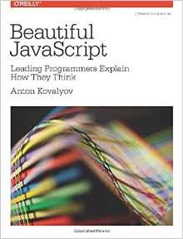 I have approached JavaScript in a crabwise fashion. A few years ago I managed to put together some visualisations by striking randomly at the keyboard. I then read Douglas Crockford’s JavaScript: The Good Parts, and bought JavaScript Bible by Danny Goodman, Michael Morrison, Paul Novitski, Tia Gustaff Rayl which I used as a monitor stand for a couple of years.
I have approached JavaScript in a crabwise fashion. A few years ago I managed to put together some visualisations by striking randomly at the keyboard. I then read Douglas Crockford’s JavaScript: The Good Parts, and bought JavaScript Bible by Danny Goodman, Michael Morrison, Paul Novitski, Tia Gustaff Rayl which I used as a monitor stand for a couple of years.
Working at ScraperWiki (now The Sensible Code Company), I wrote some more rational code whilst pair-programming with a colleague. More recently I have been building demonstration and analytical web applications using JavaScript which access databases and display layered maps, some of the effects I achieve are even intentional! The importance of JavaScript for me is that nowadays when I come to make a GUI for my analysis (usually in Python) then the natural thing to do is build a web interface using JavaScript/CSS/HTML because the “native” GUI toolkits for Python are looking dated and unloved. As my colleague pointed out, nowadays every decent web browser comes with a pretty complete IDE for JavaScript which allows you to run and inspect your code, profile network activity, add breakpoints and emulate a range of devices both in display and network bandwidth capabilities. Furthermore there are a large number of libraries to help with almost any task. I’ve used d3 for visualisations, jQuery for just about everything, OpenLayers for maps, and three.js for high performance 3D rendering.
This brings me to Beautiful JavaScript: Leading Programmers Explain How They Think edited by Anton Kovalyov. The book is an edited volume featuring chapters from 15 experienced JavaScript programmers. The style varies dramatically, as you might expect, but chapters are well-edited and readable. Overall the book is only 150 pages. My experience is that learning a programming language is much more than the brute detail of the language syntax, reading this book is my way of finding out what I should do, rather than what it is possible to do.
It’s striking that several of the authors write about introducing class inheritance into JavaScript. To me this highlights the flexibility of programming languages, and possibly the inflexibility of programmers. Despite many years of abstract learning about object-oriented programming I persistently fail to do it, even if the features are available in the language I am using. I blame some of this on a long association with FORTRAN and then Matlab which only introduced object-oriented features later in their lives. “Proper” developers, it seems, are taught to use class inheritance and when the language they select does not offer it natively they improvise to re-introduce it. Since Beautiful JavaScript was published JavaScript now has a class keyword but this simply provides a prettier way of accessing the prototype inheritance mechanism of JavaScript.
Other chapters in Beautiful JavaScript are about coding style. For teams, consistent and unflashy style are more important than using a language to its limits. Some chapters demonstrate just what those limits can be, for example, Graeme Roberts chapter “JavaScript is Cutieful” introduces us to some very obscure code. Other chapters offer practical implementations of a maths parser, a domain specific language parser and some notes on proper error handling.
JavaScript is an odd sort of a language, at first it seemed almost like a toy language designed to do minor tasks on web pages. Twenty years after its birth it is everywhere and multiple billion dollar businesses are built on top of it. If you like you can now code in JavaScript on your server, as well as in the client web browser using node.js. You can write in CoffeeScript which compiles to JavaScript (I’ve never seen the point of this). Chapters by Jonathan Barronville on node.js and Rebecca Murphey on Backbone highlight this growing maturity.
Anton Kovalyov writes on how JavaScript can be used as a functional language. Its illuminating to see this discussion alongside those looking at class inheritance-like behaviour. It highlights the risks of treating JavaScript as a language with class inheritance or being a “true” functional language. The risk being that although JavaScript might look like these things ultimately it isn’t and this may cause problems. For example, functional languages rely on data structures being immutable, they aren’t in JavaScript so although you might decide in your functional programming mode that you will not modify the input arguments to a function JavaScript will not stop from you from doing so.
The authors are listed with brief biographies in the dead zone beyond the index which is a pity because the biographies could very usefully been presented at the beginning of each chapter. They are: Anton Kovalyov , Jonathan Barronville, Sara Chipps, Angus Croll, Marijn Haverbeke, Ariya Hidayat, Daryl Koopersmith, Rebecca Murphey, Danial Pupius, Graeme Roberts, Jenn Schiffer, Jacob Thorton, Ben Vinegar, Rick Waldron, Nicholas Zakas. They have backgrounds with Twitter, Medium, Yahoo and diverse other places.
Beautiful JavaScript is a short, readable book which gives the relatively new JavaScript programmer something to think about.

